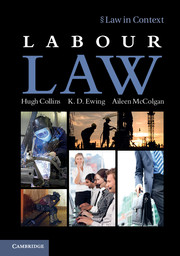Book contents
- Frontmatter
- Contents
- Preface
- Acknowledgments
- Table of cases
- Table of statutes
- Table of statutory instruments
- Table of European Union instruments
- Table of ILO instruments
- Table of other international instruments
- Abbreviations
- Part I Introduction
- Part II The contract of employment
- Part III Statutory regulation of the employment relationship
- 7 Wages
- 8 Working time
- 9 Equality
- 10 Work/life balance
- 11 Civil liberties at work
- Part IV Collective labour rights
- Part V Termination of employment
- Index
- References
11 - Civil liberties at work
from Part III - Statutory regulation of the employment relationship
- Frontmatter
- Contents
- Preface
- Acknowledgments
- Table of cases
- Table of statutes
- Table of statutory instruments
- Table of European Union instruments
- Table of ILO instruments
- Table of other international instruments
- Abbreviations
- Part I Introduction
- Part II The contract of employment
- Part III Statutory regulation of the employment relationship
- 7 Wages
- 8 Working time
- 9 Equality
- 10 Work/life balance
- 11 Civil liberties at work
- Part IV Collective labour rights
- Part V Termination of employment
- Index
- References
Summary
Much of the material in this book is concerned with human rights or fundamental rights. These rights include both civil and political rights, such as the protection of freedom of association, and social and economic rights, such as the right to fair pay and protection against unjust dismissal. As we have seen, all of those rights form part of the Charter of Fundamental Rights of the EU and therefore may influence the interpretation of labour law insofar as it emanates from EU law. Here, we focus on the implications of the Human Rights Act 1998 (HRA 1998) for the protection of individual employees in the enjoyment of their civil liberties at work. The Act provides a mechanism by which the European Convention on Human Rights (ECHR) of the Council of Europe may be legally enforceable in national courts. Without this legislation, individuals who had exhausted the available legal process under UK law were compelled to bring a claim before the European Court of Human Rights (ECtHR) in Strasbourg alleging that the national law failed to secure their Convention rights. This chapter examines the protection of workers’ privacy interests (Article 8), freedom of religion (Article 9) and whistleblowing and other issues relating to freedom of expression (Article 10). Other Convention rights protected under the HRA 1998 that are pertinent to labour law are considered in other chapters.
Interpreting the Human Rights Act
Before examining the detailed application of Convention rights in labour law, it is important to appreciate how the HRA 1998 may effect the interpretation and application of domestic labour law. Furthermore, it is necessary to note how the European Convention on Human Rights, as an international treaty regarding human rights, itself presents unique challenges with regard to its interpretation and evolution.
- Type
- Chapter
- Information
- Labour Law , pp. 408 - 444Publisher: Cambridge University PressPrint publication year: 2012



